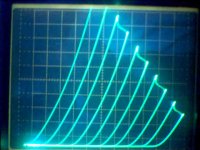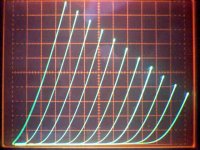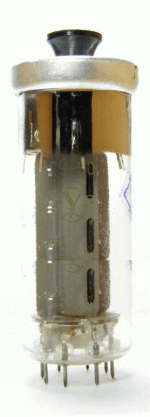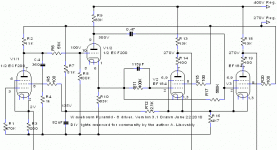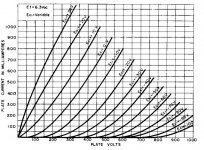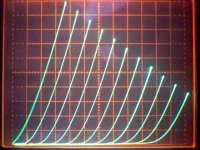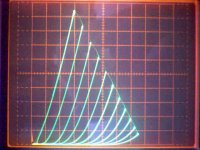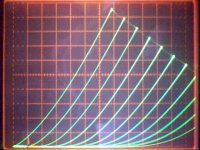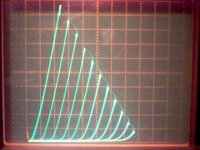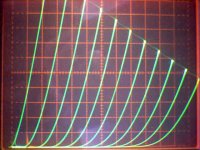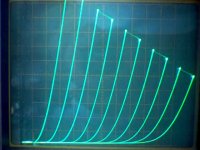Congratulations Anders! I remember Bo once told me you knew every tube there was. Seems be true.
Haha, well not quite but i guess i have dug deep into mine and others basements for useful tubes for the past 25 years. I am not really into the over-priced "super tubes". Most of the performance is in the chosen topology rather than in the tubes as long as they are fairly well suited.
BR,
Anders
Re: DualTriode
"Now add a real AC connected load, pick your impedance. AC speaking the tube is in parallel with the AC load. Do the math, the operational load line has the slope of the connected load not 0. So much for your ideal triode. "
I was speaking of constant spacing at a constant current level. I agree, that a real tilted load line usually will cause non-linearity. But the data speaks for itself.
An idea comes to mind after taking a look at these somewhat ficticious "triode" curves (1st image attached). If some scaling factor, related to plate voltage, were to scale the curvatures in such a way as to make them concentric curves, then any load line would see constant spacing. This could be achieved by a small variation in Mu (increasing) with increasing plate voltage. Some tubes, not too often, display this type of effect on their data sheets. This would need a fortuitous matched coherence with the 3/2 power law's variation of Mu downward (with increasing Vp) to compensate. No idea though how it is designed in or how it just happens. 2nd curve set is the 1E7G for comparison.
"Now add a real AC connected load, pick your impedance. AC speaking the tube is in parallel with the AC load. Do the math, the operational load line has the slope of the connected load not 0. So much for your ideal triode. "
I was speaking of constant spacing at a constant current level. I agree, that a real tilted load line usually will cause non-linearity. But the data speaks for itself.
An idea comes to mind after taking a look at these somewhat ficticious "triode" curves (1st image attached). If some scaling factor, related to plate voltage, were to scale the curvatures in such a way as to make them concentric curves, then any load line would see constant spacing. This could be achieved by a small variation in Mu (increasing) with increasing plate voltage. Some tubes, not too often, display this type of effect on their data sheets. This would need a fortuitous matched coherence with the 3/2 power law's variation of Mu downward (with increasing Vp) to compensate. No idea though how it is designed in or how it just happens. 2nd curve set is the 1E7G for comparison.
Attachments
Last edited:
Re: DualTriode
"Now add a real AC connected load, pick your impedance. AC speaking the tube is in parallel with the AC load. Do the math, the operational load line has the slope of the connected load not 0. So much for your ideal triode. "
If the curves are evenly spaced, horizontally, (i.e., constant mu) which is very nearly the case for those lovely curves that have been shown, then it does not matter if the load line is sloping! The only requirement is that you keep the operating point above the low-current area, where the curves really start to, well, curve.
You're remarkably dismissive of such obvious linearity, for someone who messes with tubes...
(Remember, only a theoretical triode follows Child's law. Real triodes only vaguely obey it, so it is entirely possible to get a near-perfect linear triode, if you're lucky)
Last edited:
Well, the 1E7G triode configured would seem somewhat limited in application.
The parallel configured triode giving:
3 Watt plate diss. (possibly 4 W if the two 0.5 W screen watts ratings can be included)
135 Volts Max. Vp
Mu 10
gm around 3000 uMho in useable range (4 to 15 mA)
Rp around 3.3K Ohm
2 Volt filament (Yuk!) Well use 3 of them, then 6.3 V, Ehh..., no, that won't work. Hummmm..... Have to use a DC filament.
Could be a nice input tube for an amplifier, or a line stage.
-----------------------------------------------------------
That 6E5P looks interesting too. Driver stage for an amp.
-----------------------------------------------------------
These "perfect triodes" really only operate ideally in SE stages where you want constant Mu. In a differential stage one wants the sum of the gm's to be constant. This requires a different type of tube. Constant Mu tubes have curved gm curves (versus plate current) and don't add up to a constant gm in P-P class A. (Causing the typical 3rd harmonic distortion seen there.) What you need for diffl. mode is one of those awful 6KR8 triodes, or 6LQ8, 12AT7 (similar triodes). The gm curves for them are closer to linear ramps, and so when summed in P-P class A are closer to constant gm.
The parallel configured triode giving:
3 Watt plate diss. (possibly 4 W if the two 0.5 W screen watts ratings can be included)
135 Volts Max. Vp
Mu 10
gm around 3000 uMho in useable range (4 to 15 mA)
Rp around 3.3K Ohm
2 Volt filament (Yuk!) Well use 3 of them, then 6.3 V, Ehh..., no, that won't work. Hummmm..... Have to use a DC filament.
Could be a nice input tube for an amplifier, or a line stage.
-----------------------------------------------------------
That 6E5P looks interesting too. Driver stage for an amp.
-----------------------------------------------------------
These "perfect triodes" really only operate ideally in SE stages where you want constant Mu. In a differential stage one wants the sum of the gm's to be constant. This requires a different type of tube. Constant Mu tubes have curved gm curves (versus plate current) and don't add up to a constant gm in P-P class A. (Causing the typical 3rd harmonic distortion seen there.) What you need for diffl. mode is one of those awful 6KR8 triodes, or 6LQ8, 12AT7 (similar triodes). The gm curves for them are closer to linear ramps, and so when summed in P-P class A are closer to constant gm.
Last edited:
"Feedback triode to linearize big sand? "
Interesting idea. Would be annoying though if they prove to sound just like the feedback resistors they replace. Guess you could always load them down some.
I could not use a triode because of huge Miller effect. Pentodes work well in Darlington with MOSFETs.
"I could not use a triode because of huge Miller effect. "
In triode feedback mode, the feedback signal goes in on the plate, the grid might be grounded, and the cathode is the attenuated low Z output. Or for a Schade network, the feedback signal goes in on the plate, the grid has the input signal, and the cathode drives the output device.
1E7G IS a dual pentode though. Could be used that way also. But the linear triode gain mode is likely only significant if something is going on at the screen grid also. Maybe an ultralinear'd driver stage. Hmmm, you know I just recently saw a schematic someone posted where the global feedback was inserted at the input stage screen grid, instead of the usual cathode insertion. 1E7G could be a excellent candidate for that setup.
In triode feedback mode, the feedback signal goes in on the plate, the grid might be grounded, and the cathode is the attenuated low Z output. Or for a Schade network, the feedback signal goes in on the plate, the grid has the input signal, and the cathode drives the output device.
1E7G IS a dual pentode though. Could be used that way also. But the linear triode gain mode is likely only significant if something is going on at the screen grid also. Maybe an ultralinear'd driver stage. Hmmm, you know I just recently saw a schematic someone posted where the global feedback was inserted at the input stage screen grid, instead of the usual cathode insertion. 1E7G could be a excellent candidate for that setup.
Last edited:
Hmmm, you know I just recently saw a schematic someone posted where the global feedback was inserted at the input stage screen grid, instead of the usual cathode insertion.
May be it was a VLF feedback, i.e.servo?
Attachments
I've seen your servo design before. Nice approach. But what I'm thinking of was posted by some Newbie as a bunch of schematics they had found on the internet. They wanted opinions on which to build. (within the last few months) I remember an odd one had the global feedback to the input tube screen grid. Likely to give the P-P design some SE sound character. It was not well liked by the commenters though, due to the non-standard approach. I thought maybe I had made a copy of it, but I can't find it if I did. Should have.
Member
Joined 2009
Paid Member
OK, its my turn. This is not quite as linear as the triodes shown here, but it isn't a little wimpy tube either. Look at the scales. I have no problem getting 75 watts out of a pair. The distortion is low without any feedback at all.
I have built a fully differential amp using three stages of dual triodes (these seperate triodes in the output stage). In fully differential class A mode (CCS in the tail of all stages) the power output was 20 watts, sounds real nice too. With fixed bias on the output stage 75 watts is possible.
Yeah, at least a dozen people strongly told me that Schade feedback is useless on triodes, and this amp has no pentodes at all, but cross coupled Schade from the output plates to the input plates reduces the distortion and tightens up the bass especially in differential mode.
I have built a fully differential amp using three stages of dual triodes (these seperate triodes in the output stage). In fully differential class A mode (CCS in the tail of all stages) the power output was 20 watts, sounds real nice too. With fixed bias on the output stage 75 watts is possible.
Yeah, at least a dozen people strongly told me that Schade feedback is useless on triodes, and this amp has no pentodes at all, but cross coupled Schade from the output plates to the input plates reduces the distortion and tightens up the bass especially in differential mode.
Attachments
You're remarkably dismissive of such obvious linearity, for someone who messes with tubes...
In my mechanical engineering world one of my biggest pet peaves is a shinny sales brochure and slick salesman that touts his product as the ultimate green and sustainable product on the market. My view of this is that I do not want to offer my client more than I can deliver.
Now to the linearity of triodes. When there were only tubes, linearity was not a topic, the goal was to minimize distortion. We did not even spend much time speaking of even vs. odd order distortion. Now we should resist the propensity to compare tubes to SS. They are of different worlds and different times.
Lets breakout triodes into manageable chunks that we can talk about; signal voltage amplifiers, power amplifiers and everything else.
Power triodes and triode strapped pentodes, my example here is the recently much touted as being the secret best contender, EL156. This tube will idle at an operating point of 50 watts and if we are lucky produce 9+ watts at 5% nonlinear distortion. That 9+ watts is near 20% of the the Class A idle power. This is no different than any other triode for the last 80 years. Am I dismissive? My challenge is to see the exceptions!
Passing over all the other stuff in between with no slight intended let’s look at signal voltage amplifiers. My example here is the 6SN7. This tube has relatively high rp when it works into a relatively high input impedance second stage; add a pentode CCS, the 6SN7 has vanishingly low perhaps difficult to measure distortion. Put an ECC189 in the just the right tuned circuit and you could sell them for $300 apiece. Am I being dismissive?
DT
All just for fun!
My example here is the 6SN7. This tube has relatively high rp when it works into a relatively high input impedance second stage; add a pentode CCS, the 6SN7 has vanishingly low perhaps difficult to measure distortion.
Both SY and Morgan Jones measured THD for the 6SN7 in the .25% and higher range.
I could not use a triode because of huge Miller effect. Pentodes work well in Darlington with MOSFETs.
This effectively implies a cathode follower, isn't it? What if a complex output stage of pentode/mosfet (i.e is used in a darlingnot configuration, as plate follower so to say?) Just a thought ... (see 2SK134/2SJ49 Inverted Daulington non NFB Power Amplifier, where the 2SJ49/2SJ50 are noted for low frequency irregularities.
albert
Out of curiosity, I traced an RCA 6SN7 to see how it compares.
a) 6SN7 2 mA/div, 20V/div, 1.2V/step this is same scale as the 1E7G plot
b) 6SN7 2 mA/div, 50V/div, 2V/step
c) 1E7G in triode
d) 12HL7 in triode
e) 38HE7 in triode
f) 6HJ5 in triode
I thought the 6SN7 would look a bit better than this.
38HE7 is a contender with Georges unknown tube. It was on sale recently for $0.33 each for a box full, still on sale at $1.00. At least it should get the title for the cheapest quality power triode. Should be good for about 15 Watts if the damper diode in the bottle is not used. (filament for pentode only across pins 10,12 21V) It has a Mu of only 4.2 and gm of 8800 uMho at 60 mA.
Looks like George's tube has a Mu of 10 and gm of 15,000 uMho at 300 mA. (or 12,500 gm at 200 mA or 10,000 uMho at 100 mA or about 8400 at 60 mA calc'd)
note: the 12HE7 does not always have the pin 10 tap for pentode filament only use. 38HE7 does seem to.
----------------
That 2SK215/2SJ49 pair is called a Complex Feedback Pair CFP or Sziklai pair, and yes would be a good model for triode control of a Mosfet. Has been discussed numerous times on tube threads. It does use NFDBK though, contrary to the article.
------------------
ECC189? Yuk, remote cutoff. http://scottbecker.net/tube/sheets/030/p/PCC189.pdf
a) 6SN7 2 mA/div, 20V/div, 1.2V/step this is same scale as the 1E7G plot
b) 6SN7 2 mA/div, 50V/div, 2V/step
c) 1E7G in triode
d) 12HL7 in triode
e) 38HE7 in triode
f) 6HJ5 in triode
I thought the 6SN7 would look a bit better than this.
38HE7 is a contender with Georges unknown tube. It was on sale recently for $0.33 each for a box full, still on sale at $1.00. At least it should get the title for the cheapest quality power triode. Should be good for about 15 Watts if the damper diode in the bottle is not used. (filament for pentode only across pins 10,12 21V) It has a Mu of only 4.2 and gm of 8800 uMho at 60 mA.
Looks like George's tube has a Mu of 10 and gm of 15,000 uMho at 300 mA. (or 12,500 gm at 200 mA or 10,000 uMho at 100 mA or about 8400 at 60 mA calc'd)
note: the 12HE7 does not always have the pin 10 tap for pentode filament only use. 38HE7 does seem to.
----------------
That 2SK215/2SJ49 pair is called a Complex Feedback Pair CFP or Sziklai pair, and yes would be a good model for triode control of a Mosfet. Has been discussed numerous times on tube threads. It does use NFDBK though, contrary to the article.
------------------
ECC189? Yuk, remote cutoff. http://scottbecker.net/tube/sheets/030/p/PCC189.pdf
Attachments
Last edited:
That 2SK215/2SJ49 pair is called a Complex Feedback Pair CFP or Sziklai pair, and yes would be a good model for triode control of a Mosfet. It does use NFDBK though, contrary to the article.
I use 6N2P and BSP225 in preamps.
- Status
- This old topic is closed. If you want to reopen this topic, contact a moderator using the "Report Post" button.
- Home
- Amplifiers
- Tubes / Valves
- Could this be a perfectly linear triode?
